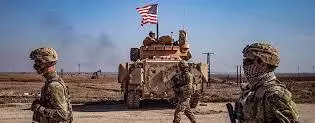
US launches strikes against Iranian-backed militias in Iraq, Syria
text_fieldsWashington DC: Dozens of sites in Iraq and Syria used by Iranian-backed militias and the Iranian Revolutionary Guard Quds force came under US military air assault on Friday in the first salvo of retaliation for a drone strike in Jordan last weekend that killed three US troops, according to officials. Officials confirming the initial strikes spoke on the condition of anonymity to discuss military activities that have not yet been announced.
More than 85 targets were struck by manned and unmanned aircraft, including command and control headquarters, intelligence centres, rocket and missile launch locations, drone and ammunition storage sites, and other buildings. According to US Central Command, more than 125 precision munitions were employed in the strikes, which were delivered by a variety of aircraft, including long-range bombers flown from the US. One authority stated that B-1 bombers were utilised.
The assault occurred only hours after Biden and top defence chiefs gathered mourning relatives to watch as the corpses of the three Army Reserve troops were returned to the US at Dover Air Force Base in Delaware, AP reported.
It was unknown what the next actions would be, or whether the days of US threats had forced militia members into hiding, making it more difficult to locate and hit them. However, it was clear that Kataeb Hezbollah, one of the primary Iran-backed militias, had no impact on the administration's intentions after it issued a statement announcing the suspension of attacks against American troops.
The US strikes appeared to avoid directly striking Iran or senior members of the Revolutionary Guard Quds force within its borders. Iran has denied being behind the Jordan strike.
In a statement this week, Kataib Hezbollah announced “the suspension of military and security operations against the occupation forces in order to prevent embarrassment to the Iraqi government.” Harakat Al-Nujaba, one of the other major Iran-backed organisations, promised on Friday to continue military attacks against US soldiers.
The United States has blamed the deadly attack in Jordan on the Islamic Resistance in Iraq, a broad coalition of Iran-backed militias, but has yet to identify a specific organisation. Kataeb Hezbollah is, nonetheless, a leading suspect.
Some of the militias have posed a threat to US sites for years, but their attacks have increased in the aftermath of Israel's battle with Hamas following the October 7 attack on Israel. Thousands of people have been killed in Gaza, and the conflict has spread to four other nations. Iran-backed militia groups around the region have used the crisis to justify hitting Israeli or US objectives, including threatening civilian commercial ships and US warships with drones or missiles in nearly daily skirmishes.
Speaking to reporters on Thursday, Defense Secretary Lloyd Austin said “This is a dangerous moment in the Middle East.” He added, “We will take all necessary actions to defend the United States, our interests and our people. And we will respond when we choose, where we choose and how we choose.”
“At this point, it’s time to take away even more capability than we’ve taken in the past,” Austin said.
According to a US military spokesman, Iran-backed militia groups have launched 166 attacks on US military locations since October 18, including 67 in Iraq, 98 in Syria, and one in Jordan as of Tuesday. The most recent incident occurred on January 29 at Iraq's Al-Asad air base, with no injuries or property damage reported.
Meanwhile, the US has strengthened defences at the Jordanian base stormed by ran-backed militants on Sunday, according to a US official.
The Israeli military said its Arrow defence system intercepted a missile approaching the nation from the Red Sea, prompting suspicions that it was launched by Yemen's Houthi rebels. The rebels didn't immediately take the blame.
A US official also stated that the military conducted additional self-defence strikes inside Yemen on Friday against Houthi military targets believed to pose an imminent threat. According to al-Masirah, a Houthi-run satellite news programme, British and American forces carried out three strikes in the northern Yemeni province of Hajjah, which is a Houthi stronghold.
While prior US reactions in Iraq and Syria have been more restricted, the attack on Tower 22, as the Jordan outpost is called, and the loss of three service members has crossed a line, according to the official.
That drone assault, which injured more than 40 military members, mostly from the Army National Guard, was the first to result in US combat deaths from Iran-backed militias since the conflict between Israel and Hamas began. Tower 22 houses around 350 US personnel and is located near a demilitarised zone on Jordan's border with Syria. The Iraqi border is just 6 miles (10 km) away.
Also on Friday, the US Treasury imposed fresh sanctions on a network of Iranian and Hong Kong-based enterprises accused of supporting Iran in obtaining technology for ballistic weapons and drones. The US imposed sanctions on six Iranian officials for allegedly committing a series of harmful cyber actions against critical infrastructure in the US and other countries.























